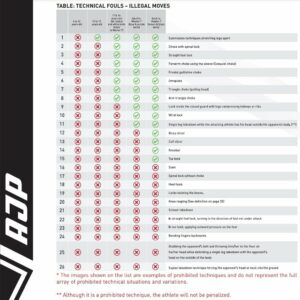The sport Jiu-Jitsu, as a competitive module of the martial art, has a complete chart of illegal moves for each category and belt level, aiming to safeguard their competitors and introduce more complex techniques gradually as athletes develop their techniques.
To make things simpler, the AJP team will take a look at some of those illegal moves, providing straightforward explanations for athletes that are coming into contact with the subject for the first time.
But remember, if you’re looking to be truly ready for your next competition, always double-check accessing the AJP Rules Book, available here.
For Kids, Infants, Junior, and Teens, there are lots of common moves that are restricted at the academy. Techniques like guillotines, arm triangles, Ezekiel chokes, and pulling the back of the head while attacking in a triangle are forbidden for the children.
The reason here is to prevent neck injuries in younger and less-experienced players. Other movements like omoplatas and footlocks are also not permitted for those young athletes.
When reaching the Youth division, and Amateur white belts of all ages, the aforementioned moves come into play, but other moves like wristlocks and forcing the closed guard to compress ribs and kidneys are still forbidden.
As the players get into Adult divisions, from blue to purple belts, wristlocks and footlocks become more commonplace, but the more dangerous techniques like kneebars, toeholds, and calf slicers are only allowed at brown and black belts.
It’s worth mentioning that some submissions like heel hooks or any movement that twists the knees, submissions that twist the spine, or footlocks spinning toward the other foot are not allowed in any belt or division.
Other moves outside the realm of submissions also have their own scale of permitted or forbidden, considering the age and belt ranking. Keep yourself and your students safe and on the right side of the rules by checking the chart below.
And don’t forget to study the Rules Book, by clicking here!


















